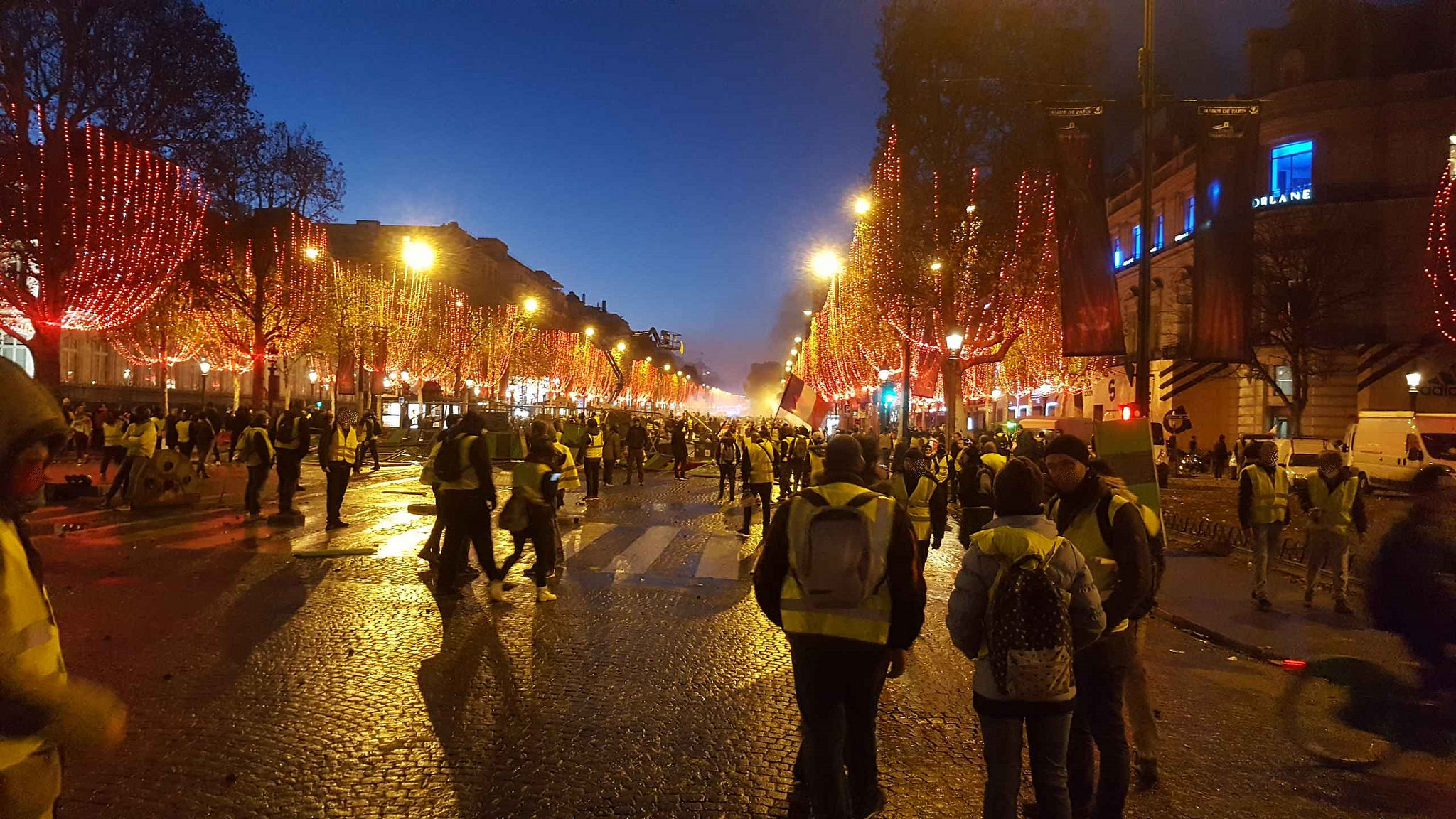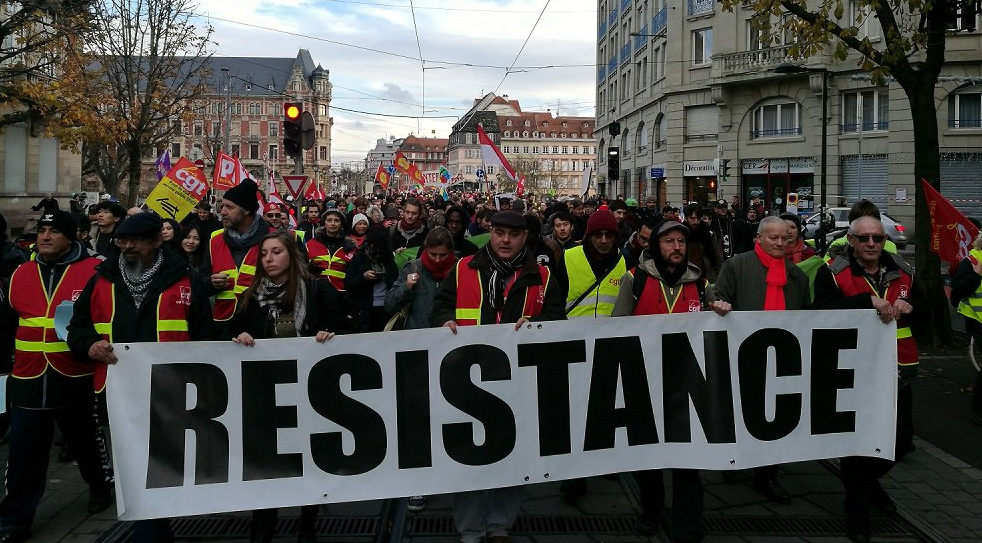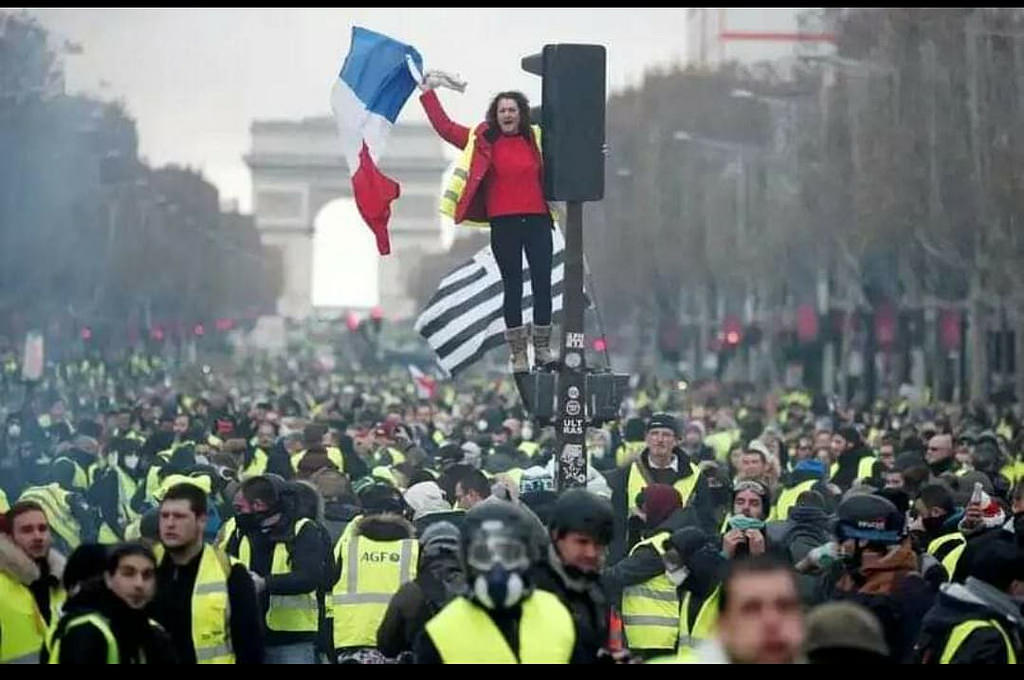Ever since 1 December, the latest day of mass protest in France, the French media have relentlessly broadcast the scenes of conflict between “yellow vest” protesters and riot police that overtook Paris. Journalists and politicians alike are running a 24/7 relay-race to “condemn all violence” – with the notable exception of violence by the riot police, which has so far resulted in the death of at least one protester, and injured many peaceful demonstrators.
High school student pickets are being brutally suppressed. On Monday, striking ambulance workers were subjected to the same fate. While official society soaks the Arc de Triomphe in hypocritical tears, the whole country is drowning under a sea of tear gas canisters and truncheon beatings.
In the meantime, despite all of their efforts, the government and its media henchmen are failing to dampen the mood in the yellow vest movement. Over 70 percent of the population continues to support it, and it is very unlikely that the government’s “concessions” (announced on Tuesday morning) will do anything to slow it down. It is all too little, too late.
The government steps back
In fact, this first step back on the government’s side will be interpreted by a number of yellow vests as proof that their struggle has paid off – and that it therefore must be intensified. In three weeks, the movement has become conscious of its own strength. Its initial demand, the lowering of fuel taxes, is now but one of the urgent measures being demanded, among others that would increase the spending power of workers, pensioners, the unemployed, small artisans, farmers, merchants etc. In the furnace of collective action, mass consciousness is taking giant strides forward every day. The question of power was put forward very early – first in a negative form (“Macron: resignation!”), then, little by little, in a positive form: “power to the people!”
Of course, in certain aspects, the movement remains politically confused. How could it be otherwise? The millions of people who have mobilised, one way or another, are in many cases doing so for the first time in their lives. These layers bring their prejudices with them. But what we should highlight is not the relative confusion of the movement; but rather its growing lucidity and radicalism. Throughout the weeks, its class physiognomy has incessantly asserted itself.We are seeing the ascendancy of the poor and the workers against the unfair politics of a government that doesn’t represent them. There are certainly worse “confusions” that the movement could run into.
 This first step back on the government’s side will be interpreted by a number of yellow vests as proof that their struggle has paid off – and that it therefore must be intensified / Image: Flickr, Erder Wanderer
This first step back on the government’s side will be interpreted by a number of yellow vests as proof that their struggle has paid off – and that it therefore must be intensified / Image: Flickr, Erder Wanderer
The right-wing and far-right demagogues are running from one television platform to another, like headless chickens, to offer their (poisoned) “support” for the yellow vests. Of course, they silently ignore most of the yellow vests’ concrete demands, such as the immediate increase of wages, pensions and safety net thresholds. Bourgeois politicians only concentrate on the lowering of taxes in general (read “for the bosses”), whereas the overwhelming majority of yellow vests are asking to remove the fiscal pressure that weighs down the poorest layers of the population – and place that burden on the richest households.
Besides, the Wauquiezes (Republican), Dupont-Aignans (independent nationalist) and Le Pens (National Front) that are haunting such platforms strain their every muscle trying to introduce nationalist ideas into the movement. But most of the yellow vests do not take easily to such ideas, which are not at the heart of their movement. On the contrary, they insist on the necessity of social reforms. In the same way, the growing mobilisation of high school students targets the government’s anti-social policies, not least among them the various measures of selection that are being implemented to restrict access to universities.
Intensify the struggle
The days to come will be decisive. With the government having taken a first step back, voices will rise from all sides to demand an immediate end to the movement and the opening of the negotiations, as announced by Macron. But it is unlikely that this course will be taken by the yellow vest movement. In suspending the few tax rises that were set for January 2019, the government is not solving any of the actual problems that millions of families face on a daily basis, families who refuse to tighten their belts any more or any longer. Macron is not adding a single penny to their monthly income. Yet the movement of the yellow vests marks the explosion of many decades of accumulated suffering and humiliation. Its momentum cannot be easily broken with such “concessions”. On the contrary, the government’s step back could encourage the yellow vests – and the whole of the labour movement – to intensify their struggle in the coming days and weeks.
The ball is now in the labour movement’s court. The left and the trade union movement must lean on the momentum given by the yellow vest movement – and its extraordinary combativeness – to put a general offensive of workers against Macron and all of his policies on the agenda. The CGT leadership calls for one grand “day of action” on 14 December. This is too far away, given the speed at which events are unfolding. But more importantly, a grand “day of action” is far from enough. During the past few years, the CGT have put on dozens of “days of action” without the slightest result. A 24-hour general strike must be seriously organised as the starting point for a movement of renewable strikes [editor: such a strike has now been declared for transport workers]. Wherever possible, the CGT must summon general assemblies of the workers, and call for a charge against the government, on the basis of an offensive programme that could inspire concrete, radical proposals on the side of the yellow vests as well.
At the top of the various left parties and of the trade unions, leaders are suggesting “ways out of the crisis”. This is a very poor approach. In the context of a powerful mobilisation of the masses, their responsibility is to intensify social and political crises, i.e. stimulate the class struggle and push it as far forward as possible. Instead of proposing this or that measure to the government in order to lower the heat, the leaders of the labour movement must turn towards the workers and do everything in their power to deepen, broaden and stimulate their mobilisation, whilst linking the struggle for reforms with the necessity to break with capitalism. Because at the end of the day, there will never be a real “way out of the crisis” until we have found a way out of capitalism itself, the continued existence of which cannot mean anything for the mass of exploited people other than permanent crisis.
Strike to bring down Macron!
On the left, Benoît Hamon (former Socialist Party candidate) is miles from any such approach. He even declared himself in favour of the rise in fuel taxes. Reformism sometimes leads to this kind of political suicide. Well, let him pull the trigger. The leadership of the French Communist Party more or less based itself on that of the CGT – i.e. the wrong position. As to the leadership of the France Insoumise (FI), it rapidly came to the support of the yellow vests and has not hesitated to criticise the CGT leadership. This is all to its credit. But now, it is in retreat relative to the general mood of the movement. To “escape the crisis”, Mélenchon asks Macron to put a number of progressive measures into motion – or, alternatively, to dissolve the National Assembly. The problem is, given the current state of the movement, it is probable that Macron will do neither one nor the other. He will hold his ground and exact brutal repression coupled, if necessary, with minor concessions. For the movement to win some serious victories, the working class must quickly and massively enter the struggle, alongside the yellow vests and the youth, in the form of a broad movement of strikes. If such a movement is launched, it will be possible to wrest some serious concessions from the government, even bring it down and then organise parliamentary elections.

Instead of explaining this, Mélenchon limits all scenarios to an “escape from the crisis”. In passing, he interprets the yellow vest movement as the living, experimental confirmation of his theses on the “citizen’s revolution”. We have already criticised these theses elsewhere. But let us simply remind ourselves that Mélenchon negates the central role of the working class and believes he has found a “new actor” in history; “the people”. Mélenchon rejoices: the yellow vests “are the people”! In the sense that the “people” are composed of multiple social classes, and not just the workers. Nevertheless, this changes absolutely nothing about the specific and decisive role of the working class in the class struggle. As it happens, strikes are the method of struggle of the working-class. And in the current phase of the class struggle in France, strikes are the decisive lever that must be employed to give a new impulse to the “people’s movement” that has risen in the country.

